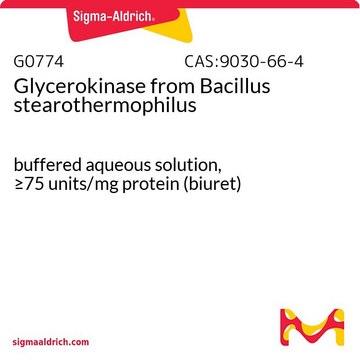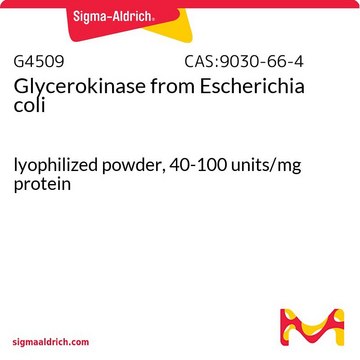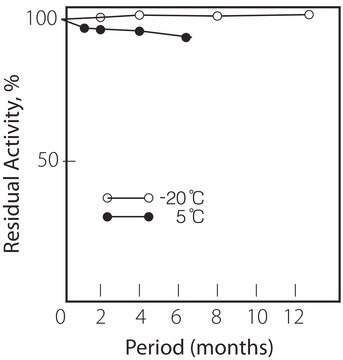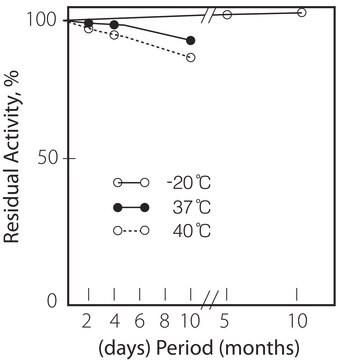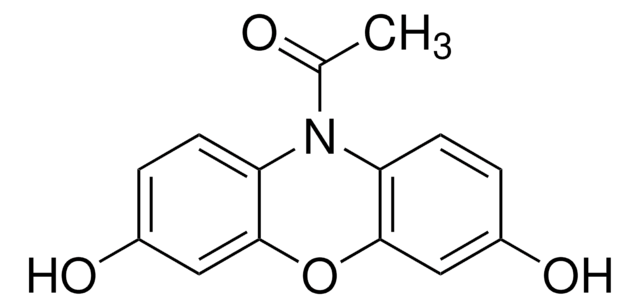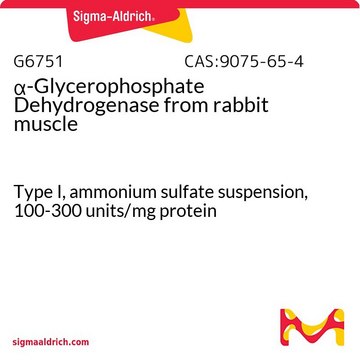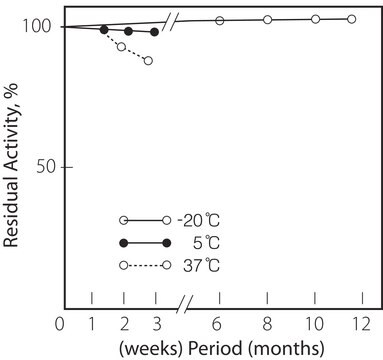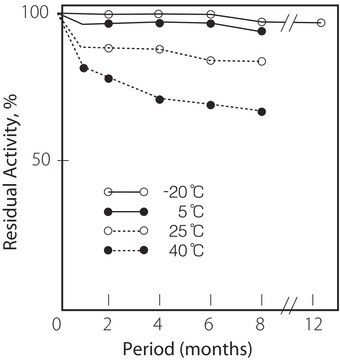G6142
Glycerokinase from Cellulomonas sp.
lyophilized powder, 25-75 units/mg protein
Sinónimos:
glpK, ATP:glycerol 3-phosphotransferase, Glycerol Kinase
Iniciar sesiónpara Ver la Fijación de precios por contrato y de la organización
Seleccione un Tamaño
Seleccione un Tamaño
Cambiar Vistas
About This Item
Productos recomendados
form
lyophilized powder
Quality Level
specific activity
25-75 units/mg protein
mol wt
~128 kDa (by gel filtration)
composition
Protein, ≥60% biuret
storage temp.
−20°C
General description
Research area: Cell Signaling
Glycerol kinase (GK) is part of the FGGY carbohydrate kinase family.
Glycerol kinase (GK) is part of the FGGY carbohydrate kinase family.
Application
Glycerokinase from Cellulomonas sp. has been used:
- for determining the kinetic characteristics of human and trypanosomatid phosphofructokinases using an enzyme-linked kinetic assay.
- to study the effect of sugar in fluorescence emission.
- in 2-Arachidonoylglycerol-based fluorescence assay for DH-463, a fluorescent activity-based probe for monoacylglycerol lipase.
Biochem/physiol Actions
Glycerol kinase catalyzes the MgATP-dependent phosphorylation of glycerol to produce sn-glycerol-3-phosphate and is the rate limiting enzyme in the utilization of glycerol. It is also subject to feedback regulation by fructose-1,6-bisphosphate.Mutations in this gene are associated with Glycerol Kinase Deficiency (GKD), a condition characterized primarily by hypertriglyceridemia and hypoglycemia. This enzyme is useful for enzymatic determination of glycerol and triglyceride when coupled with glycerol-3-phosphate dehydrogenase (=G-3-P DH, G3D-301), glycerol-3-phosphate oxidase (=G-3-P oxidase, G3O-301, G3O-311, G3O-321) or pyruvate kinase (PYK-301) and lactate dehydrogenase (LCD-209, LCD-211), lipoprotein lipase (LPL-311, LPL-314) in clinical analysis
Physical properties
Isoelectric point : 4.2
Michaelis constants : 4.4 x 10-5M (Glycerol), 4.3 x 10-4M (ATP)
Inhibitors : p-Chloromercuribenzoate, heavy metal ions (Pb++, Fe++, Hg++, Ag+)
Optimum pH : 9.8 (G-3-PDH system), 7.8 (G-3-P oxidase system) Optimum temperature : 500C
pH Stability : pH 5.5 x 10.0 (25oC, 20hr)
Thermal stability : below 40oC (pH 7.5, 15min)
Substrate specificity : This enzyme catalyzes the stereospecific transfer of the terminal
phosphoryl moiety of ATP to one of the primary hydroxyl group of
glycerol, forming sn-glycerol-3-P. The enzyme has the highest
specificity for glycerol, and also phosphorylates dihydroxyacetone
and glyceraldehyde (Table 1,2). Mg++ is essentially required for the
reaction.
Michaelis constants : 4.4 x 10-5M (Glycerol), 4.3 x 10-4M (ATP)
Inhibitors : p-Chloromercuribenzoate, heavy metal ions (Pb++, Fe++, Hg++, Ag+)
Optimum pH : 9.8 (G-3-PDH system), 7.8 (G-3-P oxidase system) Optimum temperature : 500C
pH Stability : pH 5.5 x 10.0 (25oC, 20hr)
Thermal stability : below 40oC (pH 7.5, 15min)
Substrate specificity : This enzyme catalyzes the stereospecific transfer of the terminal
phosphoryl moiety of ATP to one of the primary hydroxyl group of
glycerol, forming sn-glycerol-3-P. The enzyme has the highest
specificity for glycerol, and also phosphorylates dihydroxyacetone
and glyceraldehyde (Table 1,2). Mg++ is essentially required for the
reaction.
Unit Definition
One unit will convert 1.0 μmole of glycerol and ATP to L-α-glycerophosphate and ADP per min at pH 9.8 at 25 °C in a coupled system with PK/LDH.
Physical form
Lyophilized powder containing phosphate buffer salts and sodium gluconate
signalword
Danger
hcodes
pcodes
Hazard Classifications
Resp. Sens. 1
Storage Class
11 - Combustible Solids
wgk_germany
WGK 3
flash_point_f
Not applicable
flash_point_c
Not applicable
ppe
Eyeshields, Gloves, type N95 (US)
Elija entre una de las versiones más recientes:
¿Ya tiene este producto?
Encuentre la documentación para los productos que ha comprado recientemente en la Biblioteca de documentos.
Los clientes también vieron
Purification and properties of glycerol kinase from Escherichia coli.
S I Hayashi et al.
The Journal of biological chemistry, 242(5), 1030-1035 (1967-03-10)
Zhongya Qin et al.
Biomedical optics express, 9(7), 3373-3390 (2018-07-10)
The femtosecond laser ablation in biological tissue produces highly fluorescent compounds that are of great significance for intrinsically labelling ablated tissue in vivo and achieving imaging-guided laser microsurgery. In this study, we analyzed the molecular structures of femtosecond laser-ablated tissues
N Zwaig et al.
Journal of bacteriology, 102(3), 753-759 (1970-06-01)
The activity of glycerol kinase is rate-limiting in the metabolism of glycerol by cells of Escherichia coli. A mutant strain producing a glycerol kinase resistant to inhibition by fructose-1,6-diphosphate grows faster than its wild-type parent on glycerol as the sole
Ioanna Gouni-Berthold et al.
The British journal of nutrition, 107(11), 1694-1706 (2011-10-15)
Animal and human studies suggest that a malleable protein matrix (MPM) from whey decreases plasma lipid concentrations and may positively influence other components of the metabolic syndrome such as glucose metabolism and blood pressure (BP). The primary objective of this
Daria V Cherkashina et al.
Rejuvenation research, 14(6), 661-667 (2011-10-20)
Abstract Effects of stem and progenitor cells or their compounds on recipient cells are investigated intensively today. In spite of this, their ability to interact with native cells and the final targets affected by them, particularly biochemical parameters that characterize
Nuestro equipo de científicos tiene experiencia en todas las áreas de investigación: Ciencias de la vida, Ciencia de los materiales, Síntesis química, Cromatografía, Analítica y muchas otras.
Póngase en contacto con el Servicio técnico